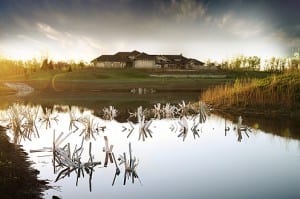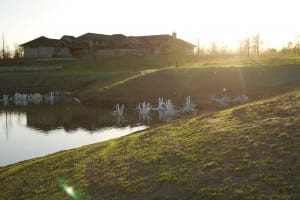A forest for the fish
If you look through the ice on a winter day, or peer into the water during a rare summer moment when the wind is calm, you might glimpse the tips of the trees that make up Ocean Lake’s underwater forest.
Below the surface is a Christmas tree forest “planted” by sportsmen and Wyoming Game and Fish in an effort to enhance fish habitat. In more than two decades some 8,000 trees have been left on the ice of Ocean Lake, tied to cement blocks to sink to the bottom providing fish habitat. It is an effort that began in the early 1980s by four friends who loved to ice fish on the lake and noticed the fish population dwindling. It has grown into a Fremont County community event where more than 500 Christmas trees are donated to the project each year.
 Kelsey Dayton
Kelsey DaytonThe result? Healthier fish populations and happier fishermen.
Howard Johnson of Riverton, always loved ice fishing. It’s a sport that takes little gear as long as one person has an ice auger. No boat is needed to catch as many fish as you would in the summer. And the cold adds a challenge and bonding experience.
“You just have to weather the weather and that’s the fun part of it,” he said.
In the early 1980s he started ice fishing with Bob Wilczewski and Scott Stanley of Riverton, along with Bob Baumann of Shoshoni at Ocean Lake.
They’d gather with their families and campers, playing cards and games and baking biscuits to go with the fresh fish they’d catch on the ice.
After a few years of bountiful hauls they noticed their catches diminishing. They knew the history of the lake, and it didn’t seem right. Dozens of unique habitat models at fishiding.com
 Christmas trees are left on the ice of Ocean Lake. Each year recycled Christmas trees are left on the ice to sink to the bottom of the lake where they provide fish habitat. (Photo courtesy Wyoming Game and Fish).
Christmas trees are left on the ice of Ocean Lake. Each year recycled Christmas trees are left on the ice to sink to the bottom of the lake where they provide fish habitat. (Photo courtesy Wyoming Game and Fish).Until the 1930s, Ocean Lake was basically a pond, about 225 acres in size, known as Dry Lake and surrounded by sagebrush and rocks, said Nick Scribner, a habitat biologist with the Wyoming Game and Fish. The Riverton Reclamation Irrigation project started in 1922.When new irrigation systems were developed in the area, water started draining to the low spot in the area, where the pond sat, covering the weeds and willows with water and making the pond more of a lake. It kept rising until the Bureau of Reclamation built an outlet off the east side to drain to a creek, stabilizing the water level, Johnson said.
Fish stocking began in the 1930s, bringing black crappie, bluegill, burbot and largemouth bass to the lake, Scribner said. Walleye stocking began in 1954 and became an annual practice starting in 1972.
Old-timers told stories of the incredible fishing in the area, especially walleye and perch, Johnson said. As the plants on the bottom began to thin and decompose, the smaller fish had no place to hide, the bigger fish had easy feasts and thrived. Fishermen caught fish “by the washtub full,” Johnson said.
For several years Johnson and his friends found Ocean Lake’s fishing bountiful. Then a few years later the fish stopped biting.
On a particularly slow day, the four men lay on the ice, put their coats over their heads and peered down to the bottom. There was nothing but mud.
“It was just like a carpeted floor down there,” Johnson said.
Ocean Lake sits northwest of Riverton in an open area exposed to Wyoming’s wind. The gusts create waves, which stir up the silt in the bottom, Scribner said.
The silt makes it hard for plants to grow and there is little natural vegetation on the bottom of the lake, he said. Small fish have little cover to hide from predators.
With no place to hide, the small fish population was decimated by the larger fish, whose population then suffered because there wasn’t enough food.
Most of Johnson’s fishing group came originally from the Midwest, where using old Christmas trees for fish habitat is common. They decided to see if they could help the fish of Ocean Lake. That winter they wandered alleys and picked up about 50 Christmas trees they hauled to the lake, tying on cement blocks and letting them sink to the bottom. A strong believer in that anyone who fishes should donate at least one day a year to projects to that helps habitat, Johnson and the group continued to collect and “plant” Christmas trees each year.
The effort became an annual event and now, with the help of the Fremont County Solid Waste Disposal District, Wyoming Game and Fish and about 20 volunteers, about 500 trees are planted in Ocean Lake each year. Johnson estimates they’ve planted about 8,000 trees since they started the project. One year, when an area business sold trees where the needles fell off quickly, they received about 1,000 trees — too many for the small number of volunteers, Johnson said.
 Volunteers bundle Christmas trees at Ocean Lake. Each year recycled trees are gathered and planted in the lake to help fish habitat. A date for this year’s event hasn’t been yet. (Photo courtesy Wyoming Game and Fish).
Volunteers bundle Christmas trees at Ocean Lake. Each year recycled trees are gathered and planted in the lake to help fish habitat. A date for this year’s event hasn’t been yet. (Photo courtesy Wyoming Game and Fish).The trees are tied together in bunches and attached to concrete blocks and left on the ice. Eventually they drop through the ice, settling on the bottom- about 15 to 25-feet below the surface, where for three or four years they’ll provide fish habitat before decomposing. The trees provide cover for small fish and perch spawn in the branches, Scribner said. Other species, like tadpoles use the habitat as well, he said. The cement blocks are left on the lake bottom, but don’t cause any environmental harm, Scribner said.
The trees come in all shapes and sizes from small “Charlie Brown”-like ones to the full and tall that would dominate a room. All of the trees break down quickly once submerged, Scribner said.
While the practice of using Christmas trees isn’t common in Wyoming, similar efforts have been done elsewhere in the state, Scribner said. In Boysen Reservoir cottonwood and pine tree stumps are put in into the lake.
While Game and Fish monitors the area and knows the trees benefit fish habitat, it’s hard to quantify the impact of the project on fish populations, Scribner said.
Johnson doesn’t need numbers. He knows the fishing is better. They are seeing more age groups of walleye. The locations the trees are dropped are tracked by GPS and those areas have noticeably improved, if a fishermen knows the lake — when and how to fish it.
“It’s all how you do it, where you do it and when you do it,” he said.
And that information, he added like any good fishermen, is a secret.
Get involved:
A date hasn’t yet been set for this year’s tree “planting.”
To volunteer with the project, contact Howard Johnson at (307) 856-1145, or contact Wyoming Game and Fish Lander office at (307) 332-2688.
To donate your Christmas tree, recycle it at no cost at the Lander landfill, Riverton bale facility or the Dubois landfill.
— “Peaks to Plains” is a blog focusing on Wyoming’s outdoors and communities. Kelsey Dayton is a freelance writer based in Lander. She has been a journalist in Wyoming for seven years, reporting for the Jackson Hole News & Guide, Casper Star-Tribune and the Gillette News-Record. Contact Kelsey at kelsey.dayton@gmail.com.



